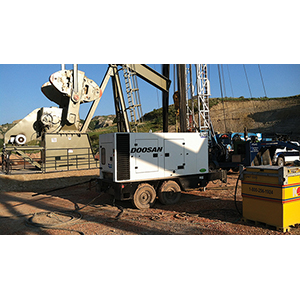
|
| A mobile generator often supplies all of the power to a jobsite, so it’s important to know how to use it wisely to minimize accidents. Source: Doosan Portable Power |
Mobile generators play a key role in the operation of a drilling site, often serving as the primary power source for the entire operation. Because of this central role, the importance of generator safety on a drilling site — or any other jobsite — should never be underestimated.
Generator safety risks can be broadly classified as mechanical and electrical. Mechanical hazards are generally easy to spot — rotating fans, moving belts — and can result in physical harm to an operator such as burns, abrasions or lacerations. Electrical risks, on the other hand, are not always visible and can result in significant harm, even death. The most serious risk is electrical shock or electrocution.
Mechanical Hazards
To avoid mechanical risks, an operator should become familiar with the machine parts, taking note of warning decals and safety guards, and following the manufacturer’s recommendations for safe operation. Most mechanical-related generator accidents can be prevented by following basic safety guidelines.
Electrical Hazards
Reducing the electrical risks associated with a mobile generator starts with proper installation by a certified individual in accordance with standard electrical practices and local codes. Proper grounding reduces many of the risks associated with generator operation, including tripped breakers, short circuits that produce sparks or arcing, and uncontained electrical current.
Incorrect electrical connections not only put an operator at risk, but can also cause significant damage to a generator, as well as the equipment being powered. The downstream effect of damaged equipment is forced downtime, costly equipment repairs or replacement and, ultimately, lost revenue.
Cable Condition
Cables are another risk factor when powering a jobsite. This includes the general condition of cables, plus the routing of cables to and around equipment on the site.
Cables are rental items that experience a tremendous amount of use and, over time, become worn. When this happens, the rubber casing can split or peel, creating a potential path for a short circuit to occur. Simply checking the condition of cables before use can help prevent a dangerous situation.
It’s also important to maintain the condition of cables by protecting them from excessive wear and tear that can easily occur when crisscrossing a jobsite. Routing cable should be done in a way that minimizes risk to people and equipment. Surveying a jobsite prior to setup can help identify the best cable path. Avoid obstacles and hazards, including standing water and heavy traffic areas that can damage cables and present a tripping hazard for workers. If heavy traffic areas are unavoidable, use cable ramps — plastic devices that protect cables from pedestrian and vehicle traffic.
Brains of the Operation
The generator control panel is another area with safety functionality. The control panel allows an operator to monitor machine function and receive warning indications should the generator begin to operate outside of safe limits. The warning display tells the operator what malfunction is occurring, and possibly how to remedy the issue. If a control panel warning is not addressed by an operator, the machine will enter protection mode and shut down.
Defense Mechanism
Safety mechanisms are built into most mobile generators through features that don’t allow the machine to operate outside of certain parameters. If a generator is overloaded, it will trip and shut down to protect the machine from being damaged. Likewise, if an engine experiences problems, the machine will shut down to prevent complete engine failure. An emergency stop button that immediately terminates operation is a common feature on most mobile generator models.
Following these guidelines can help minimize the risks associated with mobile generator operation, reducing the potential for accidents and injuries — and ensuring a safer jobsite for all.
Todd Howe is global generator products manager at Doosan Portable Power.





Report Abusive Comment